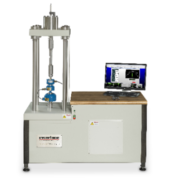Load Cell Sensitivity 101
 Load cell sensitivity refers to the relationship between the input force applied to a load cell and the output signal it generates. It is a measure of the load cell’s responsiveness to changes in the applied force and is expressed in units of mV/V (millivolts per volt) or micro-volts per volt.
Load cell sensitivity refers to the relationship between the input force applied to a load cell and the output signal it generates. It is a measure of the load cell’s responsiveness to changes in the applied force and is expressed in units of mV/V (millivolts per volt) or micro-volts per volt.
When determining the accuracy of a load cell, load cell sensitivity is an important parameter. A higher sensitivity means that even small changes in the applied force will result in a larger change in the output signal, making the load cell more sensitive and accurate.
It is critical to understand that load cell sensitivity and accuracy are closely related. A high sensitivity load cell will generate a larger output signal for the same applied force, which can increase the accuracy of the measurement. In general, the accuracy of a load cell is a combination of its sensitivity and the quality of its design and construction. Interface specializes in precision accuracy, which is important when considering the use case for your load cell. As defined by the specifications, a high-quality load cell with appropriate sensitivity will provide accurate and consistent measurements, while a load cell with low sensitivity or poor quality may provide less accurate measurements.
Most load cells are designed to measure force in one certain direction, which is determined by the way the load cell is mounted. Inappropriate loading will cause side and eccentric load, which risks reducing the life of load cells and distorting measurement results.
Eccentric load sensitivity is measured by eccentric load, which is any load applied parallel to but not concentric with the primary axis. Side load is any load at the point of axial load application at 90 degrees to the primary axis.
To achieve a desired level of accuracy, it is important to choose a load cell with the appropriate sensitivity for the application. Load cell sensitivity can be affected by factors such as temperature, temperature gradients, and environmental conditions, so it is important to take these factors into account when selecting a load cell.
What conditions impact load cell sensitivity? Load cell sensitivity can be impacted by several factors, including:
- Temperature: Changes in temperature can cause thermal expansion or contraction of the load cell material, affecting the output signal and reducing accuracy.
- Temperature gradients: The presence of temperature gradients within the load cell can cause differential expansion or contraction of different parts of the load cell, further affecting the output signal and reducing accuracy.
- Environmental conditions: Exposure to harsh environments, such as moisture, vibration, and shock, can cause damage or degradation to the load cell, reducing its sensitivity and accuracy.
- Load cell orientation: The orientation of the load cell can impact the output signal, especially in applications where the load is applied at an angle.
- Mechanical stresses: The presence of mechanical stresses, such as bending or twisting, can affect the output signal and reduce accuracy.
- Aging: Over time, the load cell may experience degradation or wear and tear, reducing its sensitivity and accuracy. This is where regular calibration plays a role in the lifetime of your load cell.
It is important to consider these factors when selecting a load cell and to properly maintain and calibrate the load cell to ensure optimal sensitivity and accuracy over time.
Calibration is a process that involves adjusting the output signal of a load cell to ensure that it accurately reflects the applied force. Calibration improves load cell sensitivity by correcting for any errors or inaccuracies in the output signal, ensuring that the load cell provides accurate and consistent readings over time.
During calibration, a series of known loads are applied to the load cell, and the corresponding output signals are measured. These measurements are used to create a calibration curve that represents the relationship between the applied force and the output signal.
Calibration helps to correct for various factors that can affect load cell sensitivity, such as temperature, environmental conditions, and mechanical stresses. By adjusting the output signal to accurately reflect the applied force, calibration helps to ensure that the load cell provides accurate and consistent readings, even in challenging conditions. Interface recommends calibration of every load cell at least once a year for regular sensitivity maintenance.
Interface engineers design high accuracy, quality load cells with appropriate sensitivity that provides accurate and consistent measurements. It is important to consider both sensitivity and accuracy when selecting a load cell for an application and to regularly calibrate the load cell to ensure that it continues to provide accurate and reliable measurements over time.








